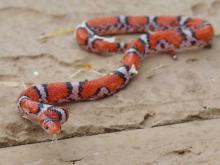Reptiles and Amphibians
Media

Species Types
Scientific Name
Cemophora coccinea copei
Description
One of Missouri's most brilliantly colored snakes is also extremely rare to find. The northern scarletsnake is similar in pattern and color to the more common red milksnake but has a red or orange snout and a spotless, white belly.
Media

Species Types
Scientific Name
Lampropeltis triangulum
Description
The harmless eastern milksnake is white, yellow, or light tan, with red or orange blotches bordered with black. The belly is white and strongly checked with black. This species often is misidentified as the venomous coralsnake, which is not found in Missouri.
Media

Species Types
Scientific Name
Aspidoscelis sexlineata viridis
Description
Prairie racerunners are fast, alert, ground-dwelling lizards. They live in open areas like fields, grasslands, and rocky, south-facing hillsides, including Ozark glades. They are related to the whiptail lizards that live in the western United States.
Media

Species Types
Scientific Name
Plestiodon septentrionalis
Description
Missouri has two subspecies of prairie skinks. They both have many stripes and a long tail. In Missouri, these lizards are rare. Northern prairie skinks occur only in our northwest counties. Southern prairie skinks are known only from Barton County, near Kansas.
Media

Species Types
Scientific Name
Plethodon albagula
Description
The western slimy salamander is a black to blue-black salamander irregularly marked with silvery flecks. It occurs in the Ozark Highlands and the Lincoln Hills north of the Missouri River. True to its name, it secretes a thick substance that sticks to skin like glue.
See Also
About Reptiles and Amphibians in Missouri
Missouri’s herptiles comprise 43 amphibians and 75 reptiles. Amphibians, including salamanders, toads, and frogs, are vertebrate animals that spend at least part of their life cycle in water. They usually have moist skin, lack scales or claws, and are ectothermal (cold-blooded), so they do not produce their own body heat the way birds and mammals do. Reptiles, including turtles, lizards, and snakes, are also vertebrates, and most are ectothermal, but unlike amphibians, reptiles have dry skin with scales, the ones with legs have claws, and they do not have to live part of their lives in water.





















